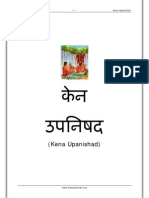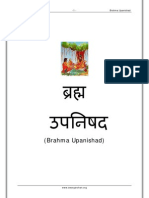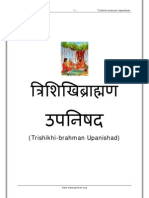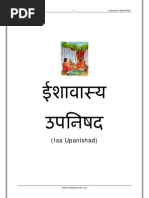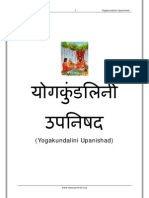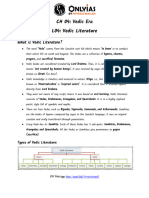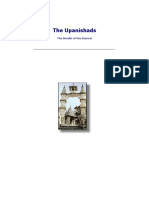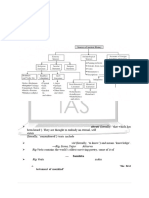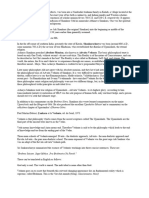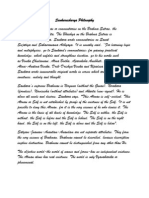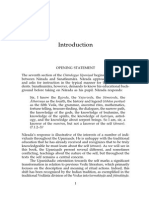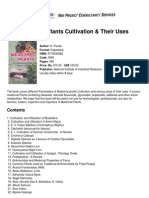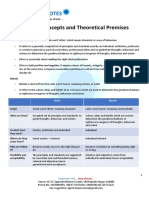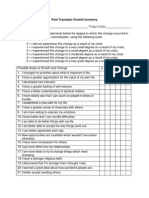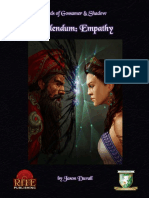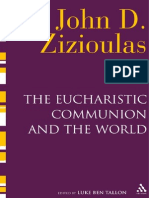Avadh Uta
Avadh Uta
Uploaded by
hjoshi1297Copyright:
Available Formats
Avadh Uta
Avadh Uta
Uploaded by
hjoshi1297Original Description:
Copyright
Available Formats
Share this document
Did you find this document useful?
Is this content inappropriate?
Copyright:
Available Formats
Avadh Uta
Avadh Uta
Uploaded by
hjoshi1297Copyright:
Available Formats
Sacred Text
-1 -
(Avadhuta Upanishad)
www.swargarohan.org
Avadhuta Upanishad
Sacred Text
-2 -
Avadhuta Upanishad
UPANISHADS: AN INTRODUCTION
The word 'Upanishad' in Sanskrit language means upa (near), ni (down) and shad (to
sit), which can be summed up as 'to sit down near' (and receive instructions). The teacher
and student or a spiritual master and his disciples setting were not always prevalent in strict
sense. In some cases, it was husband answering questions about immortality to his wife or
a teenage boy was being taught by Yama (God of Death). The teachers, in some cases were
women sages and the seekers of inspiration were kings. Besides dialogues, Upanishads also
contain narrations, similes, metaphors, illustrations and symbolism.
In the quietude of caves and monasteries or ashrams situated on the banks of holy
Ganges, this mystic knowledge was exchanged for centuries. It can be said that Upanishads
are collection of writings representing oral transmission of such knowledge.
Most of the Upanishads are either commentary on or are an extension of four Vedas
and in most cases constitute Vedanta (the end or an ultimate part of Veda). The
characteristics of the Upanishads are their universality and the total absence of any
dogmatism. Upanishads elaborate upon highest metaphysical state, beyond which is the
realm of Silence.
Upanishads are considered as the backbone of Hinduism. The thoughts expressed
inside Upanishadic cluster forms the core of Indian philosophy. One can find doctrines of
Karma (action), Yoga (union), Punarjanma (rebirth), moksha (liberation), atma (soul) and
brahman (super soul), inside these scriptures. Upanishads also gives valuable insight into
Hindu belief system behind the creation of universe and the reasons behind its sustenance.
According to Historians, Upanishads were composed between year 800-400 B.C.
Experts differ on total number of Upanishads, but most agree on 108. Major among them
are Chhandogya & Kena (Sam Veda); Aitareya & Kaushitaki (Rig Veda); Katha, Taittiriya,
Brihadaranyaka, Svetasvatara, Isa & Prasna (Yajur Veda); Mundaka & Mandukya (Atharva
Veda). From various elaboration found inside Upanishadic verses, it can be said that, sages
like Yagnavalkya, Uddalaka, Aitareya, Pippalada, Sanat Kumar, Shwetaketu, Shandilya,
Manu and even Maharshi Narada disseminated Upanishadic knowledge and thus, can be said
to be their authors.
Upanishads are acknowledged as pinnacle of human wisdom. None other scripture
of that time can claim to contain such sublime and noble thoughts as found inside
Upanishads. Written almost at the time of the dawn of civilization, Upanishads continues to
evoke tremendous interest even today, among literates of both, East as well as West.
www.swargarohan.org
Sacred Text
-3 -
Avadhuta Upanishad
www.swargarohan.org
Sacred Text
-4 -
www.swargarohan.org
Avadhuta Upanishad
Sacred Text
-5 -
Avadhuta Upanishad
www.swargarohan.org
You might also like
- Landmarks in Humanities (Gloria Fiero)Document1,044 pagesLandmarks in Humanities (Gloria Fiero)cepol93% (73)
- 1 Imam Shafi'i PDFDocument48 pages1 Imam Shafi'i PDFAL Qassim U Manjoorsa50% (2)
- The Sinisterly-Numinous AestheticDocument13 pagesThe Sinisterly-Numinous AestheticFerreira MaximilianNo ratings yet
- Brahma BinduDocument4 pagesBrahma Binduhjoshi129775% (4)
- VarahaDocument19 pagesVarahahjoshi1297No ratings yet
- VarahaDocument19 pagesVarahahjoshi1297No ratings yet
- Brahma BinduDocument4 pagesBrahma Binduhjoshi129775% (4)
- Bombay Gin 392 Full PDF With CoversDocument198 pagesBombay Gin 392 Full PDF With CoversBombayGinLit0% (1)
- Kai ValyaDocument5 pagesKai Valyahjoshi1297No ratings yet
- KenaDocument5 pagesKenahjoshi1297No ratings yet
- AtmaDocument5 pagesAtmahjoshi1297No ratings yet
- AtmabodhaDocument5 pagesAtmabodhahjoshi1297No ratings yet
- BrahmaDocument5 pagesBrahmahjoshi1297No ratings yet
- PrasnaDocument9 pagesPrasnaPushkarEENo ratings yet
- YajnavalkyaDocument5 pagesYajnavalkyahjoshi1297No ratings yet
- Adh YatmaDocument7 pagesAdh Yatmahjoshi1297No ratings yet
- SH Vet Ash VatarDocument10 pagesSH Vet Ash Vatarhjoshi1297No ratings yet
- Aitareya UpanishadDocument7 pagesAitareya UpanishadAlka SahuNo ratings yet
- Yoga ChudamaniDocument11 pagesYoga Chudamanihjoshi1297No ratings yet
- AvyaktaDocument6 pagesAvyaktahjoshi1297No ratings yet
- Vasudev ADocument5 pagesVasudev Ahjoshi1297No ratings yet
- KathaDocument11 pagesKathahjoshi1297100% (1)
- Trishikkhi BrahmanDocument13 pagesTrishikkhi Brahmanhjoshi1297No ratings yet
- Isavasya UpnishadDocument4 pagesIsavasya UpnishadSerene In100% (1)
- Kali Santa RanDocument3 pagesKali Santa Ranhjoshi1297No ratings yet
- Yoga ShikhaDocument26 pagesYoga Shikhahjoshi129780% (5)
- Yoga KundaliniDocument13 pagesYoga Kundalinihjoshi1297No ratings yet
- Amrita BinduDocument4 pagesAmrita BinduSerene In0% (1)
- Yoga TatvaDocument11 pagesYoga TatvaShuklaPradeepNo ratings yet
- Tait T IriyaDocument25 pagesTait T Iriyahjoshi1297No ratings yet
- Bri Haj JabalaDocument16 pagesBri Haj Jabalahjoshi1297No ratings yet
- Manduk YaDocument4 pagesManduk YaSerene InNo ratings yet
- MundakaDocument8 pagesMundakahjoshi1297No ratings yet
- Brahma VidyaDocument9 pagesBrahma Vidyahjoshi1297No ratings yet
- Upanishads". They Are As FollowsDocument4 pagesUpanishads". They Are As Followssantosh kumarNo ratings yet
- Vedic Era 04 - Daily Class NotesDocument10 pagesVedic Era 04 - Daily Class NotesAmit DahiyaNo ratings yet
- UpanishadDocument197 pagesUpanishadamitgautam2000100% (1)
- Ebook English UpanishadDocument197 pagesEbook English UpanishadmeytraeiNo ratings yet
- Ishads - TheDocument197 pagesIshads - TheGustav Son100% (1)
- Vedic LiteraturesDocument25 pagesVedic LiteraturesKesto Loriak100% (2)
- The Brihadaranyaka Upanishad by Swami SivanandaDocument595 pagesThe Brihadaranyaka Upanishad by Swami SivanandakartikscribdNo ratings yet
- The Upanishads: A New Translation by Vernon Katz and Thomas EgenesFrom EverandThe Upanishads: A New Translation by Vernon Katz and Thomas EgenesRating: 4.5 out of 5 stars4.5/5 (3)
- Upanishadic OverviewDocument9 pagesUpanishadic Overviewdashrishikesh108No ratings yet
- Upanisad An Introduction PDFDocument14 pagesUpanisad An Introduction PDFpranay Bin100% (1)
- IKS AssignmentDocument10 pagesIKS AssignmentVaishnavi LoyaNo ratings yet
- The Lectures On The SaivagamasDocument4 pagesThe Lectures On The SaivagamasSivasonNo ratings yet
- Sudhasindhu - Analytic Study of 12 Major UpanishadsDocument870 pagesSudhasindhu - Analytic Study of 12 Major UpanishadsDr Suvarna NalapatNo ratings yet
- Parampara India: Article On HinduismDocument4 pagesParampara India: Article On HinduismDevrajNo ratings yet
- 1.1 VedasDocument25 pages1.1 VedasPENDLI SAI SATHWIKNo ratings yet
- Foreword - KannanDocument9 pagesForeword - Kannanshesh_kgNo ratings yet
- 1. Chapter 1 Sources of Ancient Indian HistoryDocument9 pages1. Chapter 1 Sources of Ancient Indian Historyullas.laxmiNo ratings yet
- SHANKARADocument2 pagesSHANKARAphilo103No ratings yet
- Philosophy Notes47Document10 pagesPhilosophy Notes47Pradeep ThawaniNo ratings yet
- Sankaracharya PhilosophyDocument6 pagesSankaracharya PhilosophyMohan Kumar100% (1)
- UPANISHADSDocument9 pagesUPANISHADSVishnupriyaNo ratings yet
- A Glimpse of Vedic Literature: The VedasDocument3 pagesA Glimpse of Vedic Literature: The VedasSanskari YuviNo ratings yet
- Vedic and World HistoryDocument5 pagesVedic and World HistoryVēdānta StudyNo ratings yet
- The Form of The Compilation of DhammapadDocument13 pagesThe Form of The Compilation of DhammapadNiran ChueachitNo ratings yet
- Message of The UpanishadsDocument12 pagesMessage of The Upanishadsorchidocean5627100% (1)
- Brian Black, The Character of The Self in Ancient IndiaDocument27 pagesBrian Black, The Character of The Self in Ancient India9244ekkNo ratings yet
- The Vedas: The Book of The Dead Enuma Elish I Ching AvestaDocument5 pagesThe Vedas: The Book of The Dead Enuma Elish I Ching AvestaDhessa Jane LegaspiNo ratings yet
- Incredible Connection: The Unlikely Entanglement of Yoga, Harappa and Eastern Island.From EverandIncredible Connection: The Unlikely Entanglement of Yoga, Harappa and Eastern Island.No ratings yet
- Yoga ShikhaDocument26 pagesYoga Shikhahjoshi129780% (5)
- Yoga TatvaDocument11 pagesYoga TatvaShuklaPradeepNo ratings yet
- Yoga KundaliniDocument13 pagesYoga Kundalinihjoshi1297No ratings yet
- Vasudev ADocument5 pagesVasudev Ahjoshi1297No ratings yet
- Yoga ChudamaniDocument11 pagesYoga Chudamanihjoshi1297No ratings yet
- YajnavalkyaDocument5 pagesYajnavalkyahjoshi1297No ratings yet
- Trishikkhi BrahmanDocument13 pagesTrishikkhi Brahmanhjoshi1297No ratings yet
- SH Vet Ash VatarDocument10 pagesSH Vet Ash Vatarhjoshi1297No ratings yet
- Tait T IriyaDocument25 pagesTait T Iriyahjoshi1297No ratings yet
- Manduk YaDocument4 pagesManduk YaSerene InNo ratings yet
- Kali Santa RanDocument3 pagesKali Santa Ranhjoshi1297No ratings yet
- PrasnaDocument9 pagesPrasnaPushkarEENo ratings yet
- MundakaDocument8 pagesMundakahjoshi1297No ratings yet
- KathaDocument11 pagesKathahjoshi1297100% (1)
- Bri Haj JabalaDocument16 pagesBri Haj Jabalahjoshi1297No ratings yet
- Brahma VidyaDocument9 pagesBrahma Vidyahjoshi1297No ratings yet
- AvyaktaDocument6 pagesAvyaktahjoshi1297No ratings yet
- Adh YatmaDocument7 pagesAdh Yatmahjoshi1297No ratings yet
- Medicinal Plants Cultivation & Their UsesDocument5 pagesMedicinal Plants Cultivation & Their Useshjoshi1297No ratings yet
- Holy Hour and MassDocument252 pagesHoly Hour and MassPatrick Steve ReyesNo ratings yet
- Gambling Mantra To Win in All Games of Chance 108 Times: Financial Prosperity and Material Luxuries MantraDocument4 pagesGambling Mantra To Win in All Games of Chance 108 Times: Financial Prosperity and Material Luxuries MantraSutharthanMariyappan100% (2)
- Ethics Notescase Studies 1561960102937Document249 pagesEthics Notescase Studies 1561960102937Dorena Anie LiliNo ratings yet
- Pixiu: Not To Be Confused With Bixi (Mythology) or PixivDocument4 pagesPixiu: Not To Be Confused With Bixi (Mythology) or PixivLuminita GiucaNo ratings yet
- Post Traumatic Growth InventoryDocument3 pagesPost Traumatic Growth Inventorynevada hawk75% (4)
- HI GOD - Nicole CrankDocument134 pagesHI GOD - Nicole CrankRudo Tania nyamarambweNo ratings yet
- Demon The FallenDocument48 pagesDemon The Fallencalypso luneNo ratings yet
- Absen (1) EKOLOGI 7 September 2021Document21 pagesAbsen (1) EKOLOGI 7 September 2021SHALTSA NADYANo ratings yet
- The Reality of Yazeed and His Association With The Happenings of Shaheed E KarbalaDocument9 pagesThe Reality of Yazeed and His Association With The Happenings of Shaheed E KarbalaMuhaimin Abdu Aziz0% (1)
- SHINTOISM - History and DevelopmentDocument10 pagesSHINTOISM - History and Developmentabdulrahman.2014100% (1)
- History and CivicsDocument28 pagesHistory and Civicsgaming with skimiNo ratings yet
- Yb1889 BDocument208 pagesYb1889 BamgeantaNo ratings yet
- Short History of Zambales PDFDocument14 pagesShort History of Zambales PDFJoven Ian MarquezNo ratings yet
- Nawawi Commentary On Sahih of Muslim Translated by Tariq Mahmood Hashmi Part 1zDocument8 pagesNawawi Commentary On Sahih of Muslim Translated by Tariq Mahmood Hashmi Part 1zbedjo tenanNo ratings yet
- Konsep DiniDocument16 pagesKonsep DiniEndy ZQnoexNo ratings yet
- Illustrated Encyclopedia of Hinduism VolDocument429 pagesIllustrated Encyclopedia of Hinduism VolCassidy EnglishNo ratings yet
- Lords of Gossamer & Shadow - Addendum - EmpathyDocument14 pagesLords of Gossamer & Shadow - Addendum - EmpathyDonald KeebaughNo ratings yet
- The Stalled Revolution: Ten Days With Syria's Besieged ProtestersDocument6 pagesThe Stalled Revolution: Ten Days With Syria's Besieged ProtestersSamNo ratings yet
- Sri Ramana Maharshi QuotesDocument17 pagesSri Ramana Maharshi Quoteskosta22No ratings yet
- Joseph Campbell Path HeroDocument6 pagesJoseph Campbell Path HeroUeki KōsukeNo ratings yet
- Rapor Tahfidz PAT Genap 2223Document79 pagesRapor Tahfidz PAT Genap 2223Teguh JatmikoNo ratings yet
- John D. Zizioulas, Luke Ben Tallon Eucharistic Communion and The World 2011Document203 pagesJohn D. Zizioulas, Luke Ben Tallon Eucharistic Communion and The World 2011Nichifor Tanase100% (13)
- Profiles and Articles in The CEB Women's BibleDocument13 pagesProfiles and Articles in The CEB Women's BibleBible GatewayNo ratings yet
- Class XII Humanities PROJECT (1)Document2 pagesClass XII Humanities PROJECT (1)rajayush92740No ratings yet
- Passive VirtuesDocument4 pagesPassive VirtuesNikki AndradeNo ratings yet
- 7 Habits of Highly Effective PeopleDocument4 pages7 Habits of Highly Effective PeopleMahwish Zia100% (1)







